Bridal Lingerie 1911
June brides-to-be will be very appreciative of this page of pretty underwear designs which Mrs. Wilson sends to us this month. They are novel and straightforward, entirely different from what one can buy in the stores, and best of all they can be made up at home at comparatively little cost.
These designs may be had all stamped-on material which will suit the most fastidious, or one can buy the patterns and stamp her material at home.
The material best suited for underwear that is for dainty embroidered underwear is nainsook or handkerchief linen.
A great deal of the French underwear is done on nainsook, possibly because this material launders so readily, but the bride may use for her very prettiest sets handkerchief linen, which is, overall, more serviceable, and which seems a worthier material for embroidery.
The number of pieces which a bride may consider she needs are limited to tile amount she may be able to afford. It is hardly necessary to have underclothes by the dozen. A half-dozen of the various articles are enough for a modest trousseau.
In these days of scant petticoats, the corset-cover is generally used more than the fuller garments. The soubrette, however, is always comfortable, and if made to fit close and is less bulky than the unbelted chemise.
The divided skirt is often used in a soubrette, but the close-fitting ballet skirt is quite as comfortable.
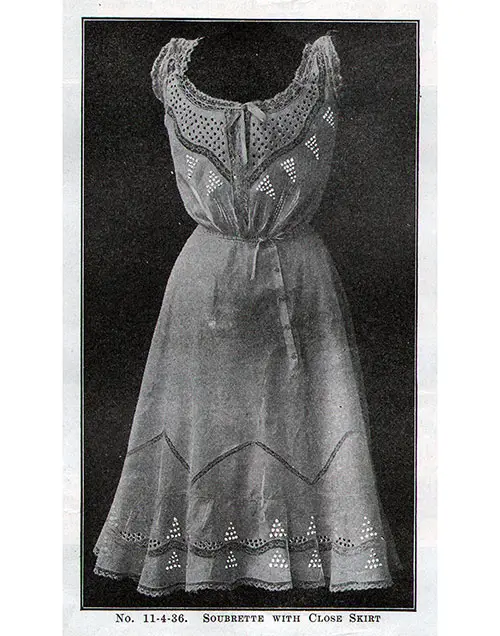
No. 11-4-36 Soubrette With Close Skirt
The garment illustrated. No. 11-4-36, depends upon dots, both solid and eyelet, for its decoration, and shows what charming results are possible with a simple motif.
The yoke effect on the corset-cover is covered with rows of dots worked as eyelets, and clusters of eyelets follow the line of lace insertion on the skirt ruffle.
The little pyramids of dots are worked solid, and the thread is not cut from the back in carrying it from one of these dots to another. The short stitch on the back may show through, but this is no disadvantage, as it seems to carry out the embroidered all-over effect very prettily.
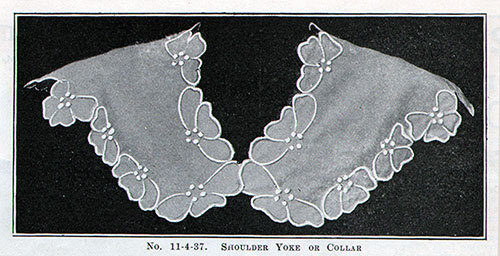
No. 11-4-37 Shoulder Yoke Or Collar
The pretty over-shoulder yoke. No. 11-4-37 is very unusual and pretty and may be used equally well as a deep collar for a negligee of accordion plaited crepe-de-chine or China silk, or a more everyday garment could be made of albatross or any of the pretty flowered materials which make such charming morning jackets.
This collar might also be used on a pongee coat or even a gown, for it is built somewhat on fichu lines. It would be exceedingly dainty made of nainsook, the material laid double, and after completing the embroidery, the underlay may be cut away, leaving the design with the material doubled on the edge. Bands of buttonhole-stitch outline the flower petals and the dots are in satin-stitch.
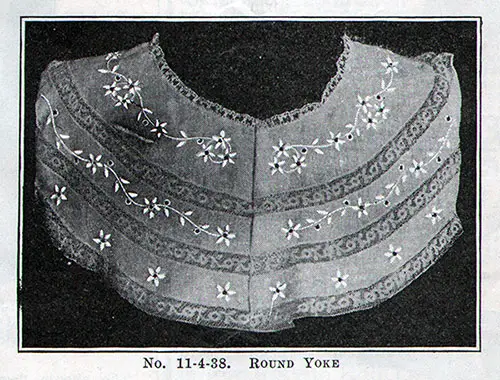
No. 11-4-38 Round Yoke
The round dressing sacque yoke. No. 11-4-38 has a pretty running design which can be used throughout a full set of underwear, as it is very adaptable.
As illustrated, it would be charming for a nightgown or dressing-jacket yoke, and omitting tile upper section of the yoke could be used in a chemise or corset-cover.
Corset-covers which do up in the back is much prettier with blouses than those opening in the front. There is so much better opportunity for embroidery on these.
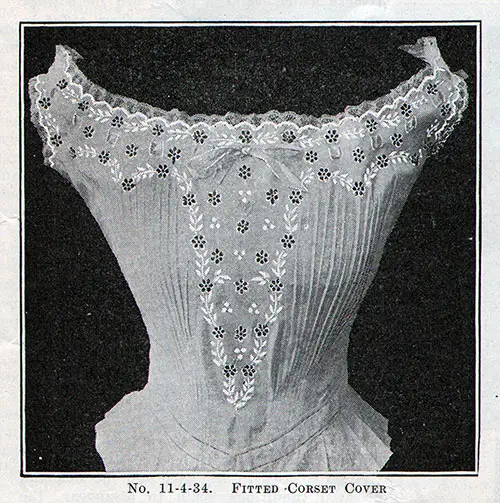
No. 11-4-34 Fitted Corset Cover
The fitted corset-cover. No. 11-4-34 is a gorgeous pattern. The fullness is held in quite close at the waistline by tucks pressed in above.
This is a most admirable way of making up a full front corset-cover, for the extra fullness is provided across the bust, and at the waistline is laid in close overlapping tucks which are not in the least bulky.
Notice that these tucks do not extend all the way across the front, but commence at either side, leaving plain material directly in the center below the embroidery.
Added shapeliness is given this underbodice by the narrow band which follows the waistline and is brought down to a point in front.
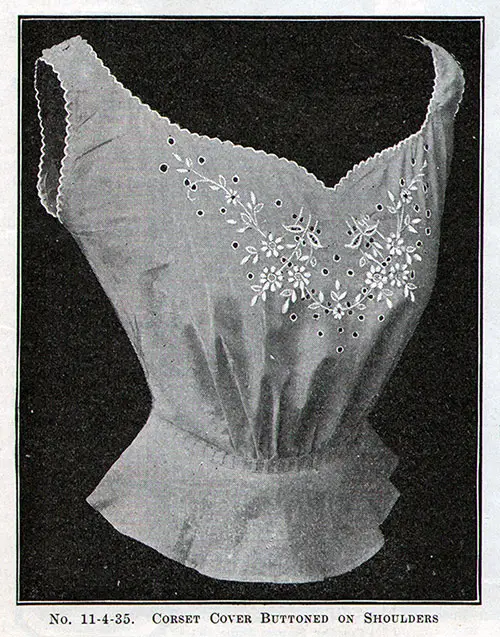
No, 11-4-35 Corset Cover Buttoned on Shoulders
A corset-cover buttoned on the shoulders is very convenient, because with a low-neck frock the shoulder strap may be separated and turned under.
The simple embroidered scallop or festoon is sufficient decoration in itself for the plain suits of underwear and can readily be completed, and since it wears so much better than lace, it is worthwhile.
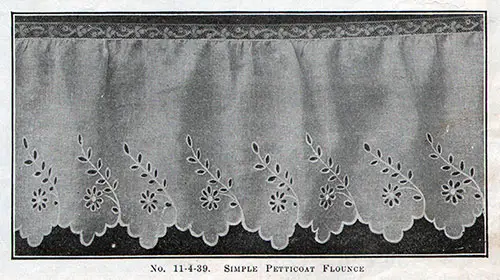
No. 11-4-39 Simple Petticoat Flounce
For the embroidered petticoat one may use an eyeleted flounce. In this way embroidering a petticoat is not such a task, since a frill of twelve or fourteen inches wide can be worked separately. The eyelets should be firmly embroidered.
To embroider an eyelet carry the running stitches around the outline, clip tile center of the eyelet, push back the material with the needle from the front and firmly bind around the eyelet over the run-in thread. Be very careful to keep the shape of eyelets in all cases.
Aside from the buttonholed edge and the dots in the centers of the flowers, all parts of the design are eyeleted, the flounce illustrated has been whipped to a Valenciennes lace insertion, but embroidered muslin beading is more often used, and readily removed from one foundation petticoat to another.
Such a flounce as this made up and joined to ribbon run beading, ready to apply, and it makes a charming gift to the bride-to-be or the girl graduate. Embroidered yokes for nightgowns also make lovely gifts.
Both yokes and flounces are often made of linen lawn or cambric, even when the body of the garment is made of some other material, such as nainsook or long cloth, so one need not hesitate because of a feeling that the entire garment should be given complete, or that the body and yoke may not match.
Many embroiderers make the mistake of selecting too elaborate designs for underwear. Much more dainty effects are possible when simple patterns like those illustrated are used, and the result is undoubtedly sufficiently handsome to please the most exacting.
Embroidery is quite the most attractive decoration one can put upon underwear and is very durable.
Illustrations, Patterns, and Pricing
No. 11-4-34. French Corset Cover. Transfer pattern, 15 cents. Perforated stamping pattern, 50 cents؛ stamped on linen Cambric, $1.10; on nainsook, 65 cents. Cotton for working, 25 cents.
No. 11-4-35. Corset Cover Closed in Back. Three sizes. 36, 38 and 40 inches bust measure. Transfer pattern, 15 cents. Perforated stamping pattern, 40 cents. Stamped on linen cambric, $1.00; on nainsook, 60 cents. Cotton for working. 10 cents. Please state size wanted when ordering.
No. 11-4-36. Combination Corset Cover and Skirt. Corset Cover. Perforated stamping pattern, 35 cents. Stamped on linen cambric, $1.25; on nainsook, 75 Cents. Cotton for working, 25 cents.
Valenciennes edging, insertion, and beading, 80 cents. Skirt Ruffle. Perforated repeating pattern, 4 inches wide, 20 cents.
Stamped on linen cambric, 18 inches wide, 50 cents a yard; on nainsook, 16 inches wide, 25 cents a yard. Cotton for working one yard, 10 cents. Valenciennes Insertion for trimming one yard. 15 cents.
No. 11-4-37. Embroidered Collar. Neck measure, 28 inches. Transfer pattern, 15 cents. Perforated stamping pattern, 30 cents. Stamped on linen or batiste, 45 cents; on nainsook, 35 cents. Cotton for working, 15 cents.
No. 11-4-38. Nightgown Yoke. Transfer pattern, 15 cents. Perforated stamping pattern, 30 cents, stamped on 5 yards linen cambric, $4.25: on 5 yards nainsook, $2.25. Cotton for working, 15 cents. Valenciennes Insertion for trimming, 30 cents.
No. 11-4-30. Petticoat Flounce. Perforated repeating pattern, 7 inches wide, 20 cents, stamped on linen cambric, 18 inches wide, 50 Cents a yard; on nainsook, 16 Inches wide, 25 cents a yard. Cotton for working one yard, 8 cents.
Stamping paste, with directions, 10 and 25 cents a box.
Work commenced on any one piece, 75 cents additional.
Nainsook is a fine, soft cotton fabric, originally from South Asia.
Wilson, Lilian Barton, “Lingerie for the Bride,” in The Modern Priscilla, Vol. XXV, No. 2, Boston, The Priscilla Publishing Co., April 1911, p. 15.
Note: We have edited this text to correct grammatical errors and improve word choice to clarify the article for today’s readers. Changes made are typically minor, and we often left passive text “as is.” Those who need to quote the article directly should verify any changes by reviewing the original material.

